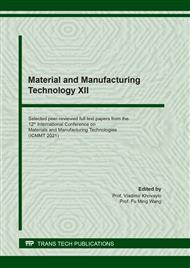p.51
p.57
p.63
p.71
p.79
p.85
p.95
p.103
p.109
A Comparative Study of the Manufacturing of BPSCCO Superconducting Wire with TiO2 Dopants
Abstract:
Bi-Pb-Sr-Ca-Cu-O (BPSCCO) superconductors are recognized as a projectable high-temperature superconductor for high-efficiency electrical applications. The addition of Ti enhances the formation of the Bi-2223 phase from the BPSCCO superconductor. The process of producing BPSCCO superconducting materials with TiO2 dopants is performed by the solid-state process and the production of wire rolling, consisting of bismuth (III) oxide powder (Bi2O3 = 99%), Strontium Carbonate powder (SrCO3 = 99%), Calcium Carbonate powder (CaCO3 = 99%), Copper Oxide powder (CuO2 = 99%), Lead Oxide powder (PbO2 = 98%) Bi: Pb: Sr: Ca: Cu ratio: 1.6: 0.4:2:2:3 doped by 1 %wt Titanium Oxide powder (TiO2 = 98.5%). The variables used in this study were the comparison of the sintering method at 860°C for 24 hours and 820 °C calcination for 20 hours, and 850°C sintering for 20 hours. The superconductor characterization was tested through the X-Ray Diffraction (XRD) test, Scanning Electron Microscopy (SEM), and Resistivity test. XRD test results showed the formation of Bi2Sr2CuO6 and Bi2Sr5Cu3O16 phase. SEM results showed an increase in grain size. The resistivity test results showed that all samples formed critical temperatures, 9.6 and 9.5K respectively.
Info:
Periodical:
Pages:
79-84
Citation:
Online since:
August 2021
Keywords:
Price:
Сopyright:
© 2021 Trans Tech Publications Ltd. All Rights Reserved
Share:
Citation:


